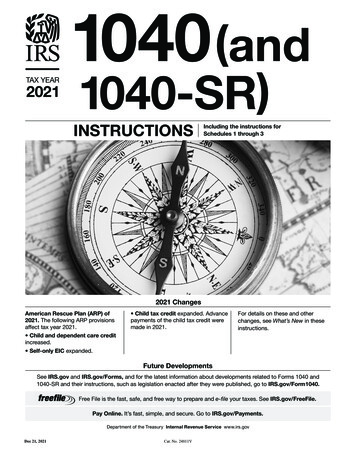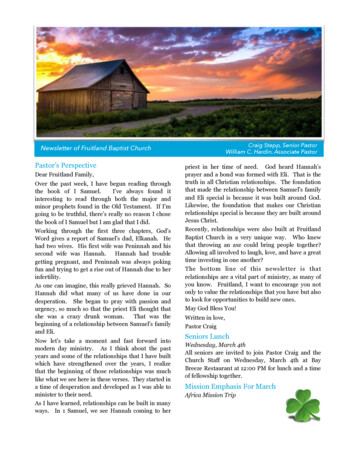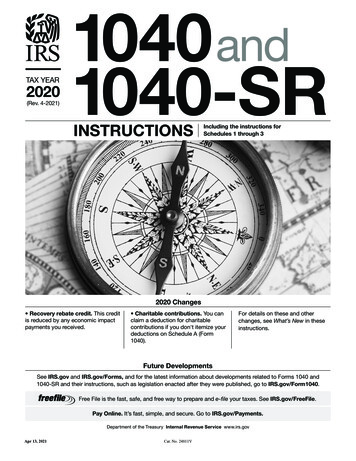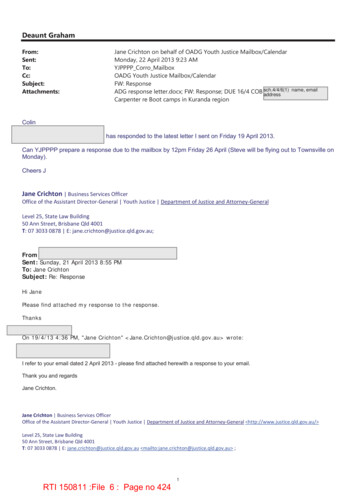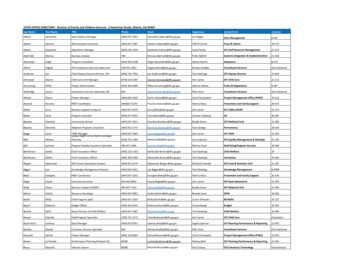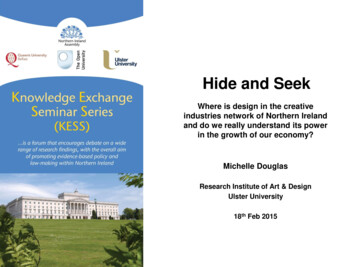
Transcription
Hide and SeekWhere is design in the creativeindustries network of Northern Irelandand do we really understand its powerin the growth of our economy?Michelle DouglasResearch Institute of Art & DesignUlster University18th Feb 2015
Very little recognition of design as a distinct and essential factor insuccess within the wider arena of Creative Industries in NorthernIreland. No policy or ministerial advisory committee that promotes the value ofdesign in Northern Ireland. No physical space or a council to advise on design policy or academicresearch for the creative industries. Design is currently aligned with the Creativity Industries sector under theDepartment of Culture Arts and Leisure (DCAL). Design could be more visible / aligned with the Innovation sector ofDepartment of Enterprise Trade & Industry (DETI)
GVA of the Creative Industries (CI) was 76.9bn in 2013 andaccounted for 5.0 per cent of the UK Economy.Growth in the CI was higher than in any other UK industry andwas three times the average increase in the UK economy duringthe period.The 9 sectors in the CI including architecture, crafts, design, film,games, publishing, museums and galleries, music, IT softwareand computer services and television.1.71m jobs in 20135.6 per cent of total UK jobs – (a 1.4 per cent increase on 2012)
Employment in the Creative Economy 2011 - 2013Image Source: Creative Industries Economic Estimates – Jan 2015 (DCMS 2015)
Northern Ireland CI StatisticsGross Added Value change 2011 – 2012 by industryImage Source: Creative Industries Economic Estimates NI Experimental Statistics – (DCAL, 2014)
Creative Enterprises operating in NI2009 - 2013More than a third (35.8%) of allcreative enterprises in NorthernIreland in 2013 were in the IT,software and computer servicesgroup.In addition, this group showed thelargest annual average increase overthe period 2009-2013 of 3.6%, with2013 showing an increase of 8.1%when compared with 2012.Design and Advertising & marketingwere the only other creative industrygroups with annual averageincreases in their number ofenterprises for 2009-2013 (2.0% and1.5%, respectively).Image Source: Creative Industries Economic Estimates NI Experimental Statistics – (DCAL, 2014)
Creative Industries OccupationsImage Source: Creative Industries Economic Estimates – Jan 2015 (DCMS 2015)
Design orientated careersAdvertising and MarketingCraftsMarketing and Sales directorsAdvertising and public relations directorsPublic relationships professionalsAdvertising accounts managers and creative directorsMarketing associate professionalsSmiths and forge workersWeavers and knittersGlass and ceramics makers, decorators and finishersFurniture makers and other craft woodworkersOther skilled trades not elsewhere classifiedDesign: product, graphicand fashion designGraphic DesignProduct, clothing and related designersIT, software and computerservicesInformation technology and telecommunications directorsIT business analysts, architects and systems designersProgrammers and software development professionalsWeb design and development professionals
Invest NIImage ies.html
Creative ScotlandNI Design AllianceDesign WalesDesign CouncilLondon Design FestivalYear of Irish Design 2015
What is design?Design is a diverse sector encompassing a wide range of professions and activities, includinginteraction design, system design, automotive design, sustainable design, retail design,product design, service design, graphic design as well as architecture and urban designdisciplines.Overview“Great design can change lives, communities and organisations forthe better. It can create better places to live, and bringcommunities together. It can encourage healthier living. It cantransform business and public services.” The Design Council 2015Philosophy“Design is the conscious and intuitive effort to impose meaningfulorder.” Victor Papanek (b. 1923 – d.1998)Process“Design thinking is a deeply human process that taps into abilitieswe all have but get overlooked by more conventional problemsolving practices.” Tim Brown, IDEO
ProductProcess
What does the process look like?Image gn/process
Image lantgrowth/reference/Eng Design s.jpg
ContentUser ExperienceUser InterfaceExperience DesignService DesignGame DesignApps
Design for Social InnovationDesign for Public ServicesDesign ThinkingDesign is about finding innovative solutions to meet human needs.
‘Design is what links creativity and innovation. It shapes ideasto become practical and attractive propositions for users orcustomers. Design may be described as creativity deployed to aspecific end.’ Cox Review of Creativity in Business, 2005
· Design professions: central to the strength of the UK’s creative and engineeringindustries. Also support innovation in many other sectors.· Manufacturing, science and technology: design approaches support new productand service development, open new markets, help to better understand users andinvestor needs and aid long-term planning.· Design is highly export-facing.· The UK’s leading engineering/manufacturing sectors of high-tech, aerospace,energy, automotive, chemical and food production rely on engineering design, designskills and other design disciplines to develop ideas pre-production and tosuccessfully take products to market.Source: cmselect/cmcumeds/writev/suppcrec/sce70.htm
“Successful firms such as Jaguar Land Rover embed design throughouttheir product and service development, as well as marketing and sellingstrategies, and design thinking is integrated at the highest strategic levelinto boardrooms in some of the world’s most successful companies, asthe well-cited example of Apple shows.”Source: cmselect/cmcumeds/writev/suppcrec/sce70.htm
Design increases turnover:for every 1 businesses invest in design, they can expectover 20 in increased revenues (Design Council, 2012)
ReferencesCommittee for Culture, Arts & Leisure. (2013). Inquiry on Maximising the Potential of the Creative Industries: Volume One. Belfast: NorthernIreland Assembly.Council, D. (2012, November). Parliamentary Business, Publications and Records. Retrieved from c/sce70.htmCreative & Cultural Skills. (2014). Mapping the Design Industry in Northern Ireland. Belfast: Creative & Cultural Skills.Creative Industries Council. (2014). Create UK: Creative Industries Strategy. London: Creative Industries Council UK.Department of Culture, Arts and Leisure. (2014). Creative Industries Economic Estimates Northern Ireland: Experimental Statistics 2014.Belfast: Northern Ireland AssemblyDepartment of Culture, Arts and Leisure. (2013). Creative Industries Economic Estimates Northern Ireland: Experimental Statistics. Belfast:Northern Ireland Assembly.Department of Culture, Media and Sport. (2014). Creative Industries Economic Estimates January 2014. London: DCMS.Design Council. (2012). Designing Demand. London: Design Council.DETI. (2013). Northern Ireland Innovation Council: Supporting Evidence/Research Paper for the Draft: Innovation Strategy for Northern Ireland2013 - 2025. Belfast: DETI.Digital Circle. (2014). Digital Circle. Retrieved Oct 15, 2014, from http://digitalcircle.org/businessesFast Company. (2014). Retrieved Oct 2014, from http://www.fastcompany.com/IDEO. (2014). IDEO: About. Retrieved Sept 21, 2014, from http://www.ideo.com/about/Just UX Jobs. (2014). http://www.justuxjobs.co.uk/. Retrieved Oct 15, 2014, from http://www.justuxjobs.co.uk/KELLEY, T. (2008). The Ten Faces of Innovation: Strategies for Heightening Creativity. London: Profile Books.Landry, C. (2014). Charles Landry. Retrieved Oct 1, 2014, from dex/Northern Ireland Design Alliance. (2014). NI Design Alliance Design Directory. Retrieved Oct 15, 2014, fromhttp://directory.nidesignalliance.com/#/The Design Council. (2014). Design Council: About us. Retrieved Sept 20, 2014, from tand
GVA of the Creative Industries (CI) was 76.9bn in 2013 and accounted for 5.0 per cent of the UK Economy. Grow





